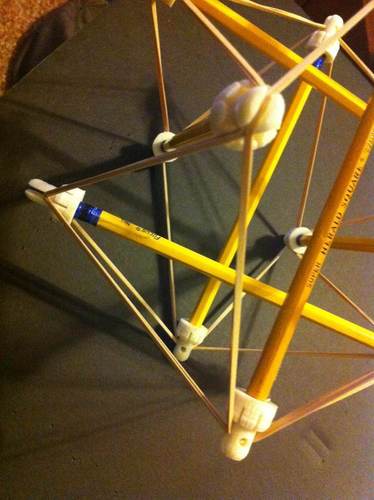
Tensegrity Topper
pinshape
Summary Tensegrity Toppers for use in STEM/STEAM curriculum to help develop easy-to-assemble kits that demonstrate ways of building these types of structures; just connect standard #2 pencils or wood dowels/carbon fiber rods for struts and rubber bands, floss, or wire as tension strands. These should print without support. Most tensegrity examples require you to saw, cut, or notch dowels which need sharp tools, repetitive cuts, and may be unsafe in a class setting. Other methods require rubber caps, utilize tape+string, and/or straws+paperclips that may not be as stable, efficient, or scalable. There are other types of kits available but are either out-of-print and/or cost-prohibitive to scale for a class setting. A challenge with tensegrity models is that they tend to collapse while being constructed, so patience is needed. It helps to have a system of jigging them to hold them in position while making connections and cutting tension strands to length. You can utilize the notch structure at the base of tensegritytopper08 to help hold connections in place temporarily. You can use knotted floss or smaller rubber bands to help hold struts together while assembling it then remove/cut away supports once assembled. Tensegritytopper08_simple is a simplified nock setup to quickly put together standard structures without additional complexity. Tensegritytopperplug.stl is used to cover the ends; this can be used to hold bands in place so they don't slip out during build but it's optional. They can also be printed in different colors for visual variety. Depending on how much tension you want/require, you can use one longer band instead of multiple shorter bands; photos included provide an example that shows two smaller rubber bands as tension strands and also includes some extra tension bands that are probably not needed. Some options to consider are playing with adding or removing tension bands at different points in the structure, connecting tension between middle points on a strut as well as testing bounce/rigidity of the structure. The toppers can be printed in different colors and you can use a variety of different colors/length of rubberbands as well as using color pencils instead of standard #2 yellow pencils. Tensegrity Structures; http://www.tensegriteit.nl/index.html Tensegrity Robots; http://www.wired.com/2015/03/robot-collapses-pressure-good-way/
With this file you will be able to print Tensegrity Topper with your 3D printer. Click on the button and save the file on your computer to work, edit or customize your design. You can also find more 3D designs for printers on Tensegrity Topper.
